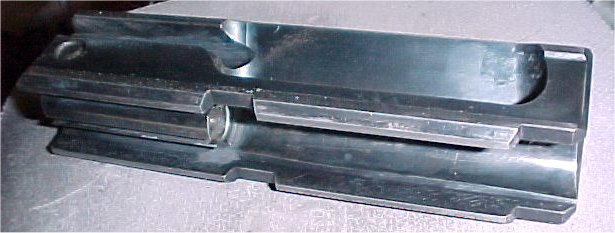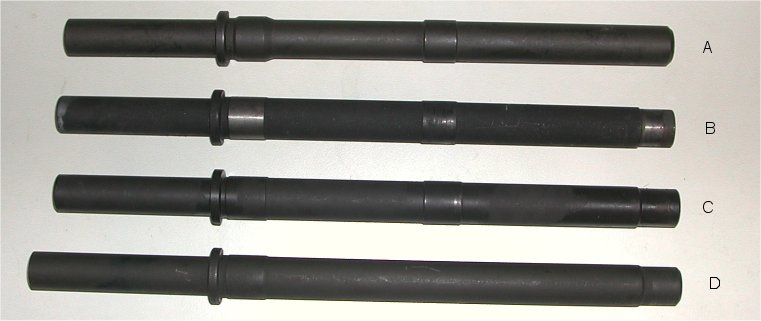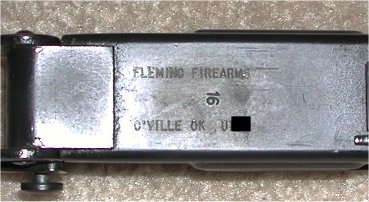
UZI Conversions - Full Size
 |
UZI Conversions - Full Size |

The Model A and Model B semi automatic UZI carbines all had a bolt blocking
bar welded to the inside of the receiver. This bar prevents an unmodified SMG
bolt from being used in the gun and was required by the ATF to get approval to
sell the gun in the US. Removal of this bar is considered to be manufacturing a
machinegun, and results in what is known as a "registered receiver". That is the
preferred way to convert an UZI and permits the use of unmodified SMG bolts. Not
all of the transferable registered receivers converted before 1986 had the
blocking bar removed. Some people registered the receiver but used a slotted
bolt with it. In those cases, the bolt was usually unmarked (since it was not
the registered part) but it is "married" to the receiver because separating it
from the receiver would create an unregistered machinegun. Because of that, a
registered receiver that still has the block bar attached is no more versatile
than a registered bolt.
Since May of 1986, only class II dealers can create a new machinegun by removing
the blocking bar and the gun is considered to be a dealer sample, not
transferable to individuals.
 Instead
of removing the blocking bar, many people created a registered bolt by taking a
standard SMG open bolt and milling a slot on the side so it could pass over the
block bar. For people doing transferable conversions before 1986, doing a
registered bolt was convenient because they could get a large supply of bolts
and the conversion process was easy. B&G is probably the most common registered bolt
around today. Here's a picture of a registered B&G bolt. The vast majority of
registered bolts are open bolts, but there are a few registered closed bolts.
They were usually made by taking a semi automatic closed bolt and welding up the
lower lip so they'd run properly as a full auto. The welded up lower lip is not
as durable as an original factory bolt.
Instead
of removing the blocking bar, many people created a registered bolt by taking a
standard SMG open bolt and milling a slot on the side so it could pass over the
block bar. For people doing transferable conversions before 1986, doing a
registered bolt was convenient because they could get a large supply of bolts
and the conversion process was easy. B&G is probably the most common registered bolt
around today. Here's a picture of a registered B&G bolt. The vast majority of
registered bolts are open bolts, but there are a few registered closed bolts.
They were usually made by taking a semi automatic closed bolt and welding up the
lower lip so they'd run properly as a full auto. The welded up lower lip is not
as durable as an original factory bolt.

It has been reported that some of the early semi automatic Model A carbine's that came into the US had a fully supported bolt face. Representatives from IMI have denied it and the ATF probably wouldn't have allowed it, but it's possible that IMI forgot to mill off the lower lip on some of the bolts or the ATF didn't initially realize that it was an issue. It's also possible that IMI made these bolts available separate from the guns for conversion purposes. Regardless of how they got here, original slotted IMI closed bolts with a lower lip do exist but they are quite rare. They would have been an ideal bolt to register prior to 1986, requiring no modifications to the receiver or the bolt.

When transferable conversions were being done in the 1980's, surplus UZI parts were harder to come by and more expensive than they are today, so there was more incentive to convert existing semi parts then to replace them with SMG parts.
Sears :
:
Conversions could also be done via registered sears. Fleming removed the bolt
blocking rail from the receiver and engraved his information on the bottom of
the receiver as seen in the picture below. The sear was also crudely engraved
with the same info with a vibrating pencil engraver. These sears are permanently
married to the receiver and cannot be removed. While this information may not be
documented on the current form the gun is on, it should be. Qualified did some registered sears that are not married to the receiver but
are extremely rare.
Receiver Markings:
As a final touch, people doing conversions may have restamped the receiver
markings to make the gun look like an original SMG. Most conversions were not remarked. Fleming did a "Basic" and "Deluxe" UZI
conversion. The Deluxe consisted of remarking the receiver to say "UZI SMG"
(although a
factory IMI UZI should really be marked "SMG UZI"). The Deluxe also had the lower
remarked to ARS while the Basic was usually AFS.
Copyright © 2002-2017, UZITalk.com
International copyright laws
DO apply to
Internet Web Sites!
All Rights Reserved.
Last Modified: March 12, 2017
Contact:
librarian@uzitalk.com